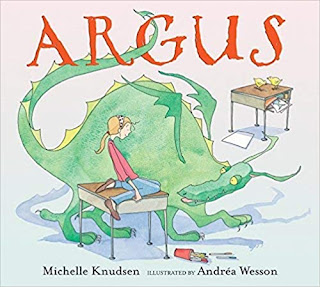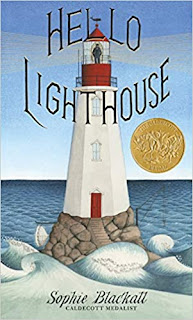Written and Illustrated by Sophie Blackall
This is an incredible journey of a lighthouse keeper.
What did he do? Sophie Blackall writes, he "polishes the lens" and "winds the clockwork that keeps the lamp in motion".
Now, here is some food for thought. Did you know lighthouses had keepers who took care of lighthouses?
I did not!
I read the story and the author's note. It was incredulous.
Long long ago, lighthouses had keepers. They would toil "from sunset to sunrise" ensuring that the lighthouse would beacon signals to the ships and mariners, guiding them on their onward journey; as during day time the sun would reveal the surroundings to them; but come night time ...who would?
That was when lighthouses would serve as nocturnal guides.
Sophie Blackall unveils the story, when a new keeper arrives to work in a lighthouse.
The work he does is unfathomably arduous.
Come fog, hail, rain, snow or shine, the lighthouse keeper had to ensure that the light of the lighthouse would burn continuously. No matter what the weather, he had to ensure that the lens would be crystal clean as a tiny smidge of dust could destroy the focused rays of the beam and could prove dangerous to the mariners.
Amidst seagulls, waves and reefs for company, it must have been a terribly lonely life and to prevent monotony from seeping into his life, the keeper would fish, cook, sing, paint, write letters.
Who knew that the rooms were circular and that they were stacked one on top of the other, like a multistoried building?
Who knew that the stairway that led from one floor of the lighthouse tower, to the next floor were spirally?
Who knew that there were cellars of oil barrels that would provide oil for the lighthouse lamp?
I did not.
Surrounded by the gales and thunderstorms, and not a soul in sight, the lighthouse keeper must have been incredibly brave.
Life as a lighthouse keeper must have been enormously hazardous.
I wonder how they would communicate during their difficulties...?
As I returned to the book, I was humbled by the story.
The art work is brilliant. A Caldecott Gold awardee, Sophie Blackall's Hello Lighthouse is an astonishing story of a lighthouse keeper's odyssey as he tries to maintain his life and and serve as a watch guard to the innumerable ships as they would cruise the choppy and calm seas, transporting folks and freight. Maybe live-stock too?
I was struck by the unknown and unsung heroes who had provided rays of hope to the ships and their crew with their extraordinary acts of bravery.
When I was writing this blog, I did a bit of research and I found...
"The first known lighthouse was the Pharos of Alexandria, Egypt. Ptolemy I and his Ptolemy II constructed it between 300 and 280 B.C. It was about 450 feet high."
Please read on for some interesting lighthouse facts...
The book is an absolute must read.
Image source: www.amazon.com | Publisher: Little, Brown, and Company.



